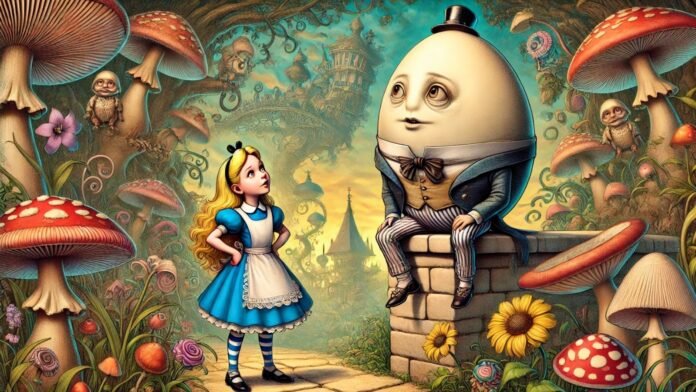O frabjous fourth! Every July 4, Alice in Wonderland fans flash Cheshire grins, chase White Rabbits down imaginary holes, hold tea parties and tip their ‘Mad Hatter’ hats to Charles Dodgson—better known as Lewis Carroll. After all, the fantastical tale was born on a legendary “golden afternoon” on this very day in 1862.
The ever-curious Alice was inspired by Carroll’s young neighbour, Alice Liddell, a precocious five-year-old, who became his muse. During a leisurely boat trip along the Thames, Dodgson—a mathematician —improvised the story to entertain her. Lured down the rabbit hole, Liddell begged him to write it down. Two years later, she received the first manuscript, Alice’s Adventures Under Ground, complete with Dodgson’s illustrations. The Alice in Wonderland series includes two books Alice’s Adventures in Wonderland (1865) and Through the Looking-Glass (1971).
Though 160 years have passed since its publication, Alice’s magic only grows “curiouser and curiouser.” Like the ever-accommodating rabbit hole that keeps Alice intrigued no matter her size — she keeps shrinking and shooting up — the story’s colourful metaphor, fabulous imagery, and linguistic whimsy continue to captivate readers of all ages and from all walks of life. The childhood classic has become a cornerstone of English literature.
This July 4, we celebrate the novel’s linguistic genius, its nonsense words and playful phrases, some of which have even made it to dictionaries.
Callooh! Callay! Let’s dive in:
📌 Jabberwocky A nonsense poem about how a young man slayed the Jabberwock, a fearsome creature in Wonderland. Its playful language (“Beware the Jabberwock, my son!The jaws that bite, the claws that catch!”) turned “jabberwocky” into a term for gibberish.
📌Portmanteau – Before Carroll reimagined it, the word simply meant a two-part suitcase, from the French porter (to carry) and manteau (cloak). Now, it describes blended words such as brunch (breakfast and lunch) and smog (smoke and fog), since Through the Looking-Glass was published in 1871.
📌 Galumph A triumphant yet clumsy stride, marrying gallop and triumph. After slaying the Jabberwock, the hero “went galumphing back.” According to Oxford Languages, the word has galumphed into the mainstream, peaking around 2019.
Story continues below this ad
📌Chortle Before 1871, laughter was just giggles or snorts. Then, Carroll invented chortle, a gleeful hybrid of chuckle and snort, and it became after that it became giggle and snorts, forever solving the dilemma of how to describe a snuffling giggle.
 The Jabberwock, as illustrated by John Tenniel, 1871. (Photo: Wikimedia Commons)
The Jabberwock, as illustrated by John Tenniel, 1871. (Photo: Wikimedia Commons)
📌 Frabjous A fabulous and joyous mash-up for deliriously happy days. Carroll’s exclamation—“O frabjous day! Callooh! Callay!”— deserves revival every time you ace a test or find the last slice of pizza.
📌Snark Teens were not snarky (just sarcastic) until Carroll dreamed up the Snark, a creature from his 1876 poem The Hunting of the Snark. Now, it is the go-to term for sarcasm with extra bite.
📌Boojum One better reign in Snark, lest one become a Boojum. In Carroll’s world, a Boojum — another fearsome creature — vanishes mid-sentence amid a flurry of gibberish. As he puts it: “In the midst of the word he was trying to say,/In the midst of his laughter and glee,/He had softly and suddenly vanished away— For the Snark was a Boojum, you see.”
Story continues below this ad
📌Slithy (obsolete) A slippery blend of slimy and lithe, used to describe the “slithy toves” that gyre and gimble. Ideal for eels, politicians, or overcooked spaghetti.
 The Barrister’s Dream, with a snark in the foreground, in robe and wig. (Wikimedia Commons)
The Barrister’s Dream, with a snark in the foreground, in robe and wig. (Wikimedia Commons)
📌 Tove A badger-lizard hybrid that “gyres” in the wabe (the grass around a sundial). No toves in your backyard? Substitute any small, fast reptile.
📌Gimble Not to be confused with gimbals (camera stabilizers). In Wonderland, it means to bore holes—a favorite pastime of slithy toves and termites.
📌 Mimsy A withering portmanteau of miserable and flimsy. Use it for half-hearted apologies, or “water-resistant” phone cases.
Story continues below this ad
📌Vorpal It is a blade sharp enough to slay a Jabberwock. Fantasy gamers adopted it because “vorpal blade” certainly sounds cool.
📌 Bandersnatch A ferocious beast from Through the Looking-Glass and also the title of a Black Mirror episode. It indicates a furious disposition. Today it describes anyone who makes a nuisance of themselves.
📌Frumious When fuming meets furious. Perfect for describing a Bandersnatch’s mood or that of your boss after deadline.
📌Burble A flustered mix of bleat, murmur, and warble. The sound you make when caught in an embarrassing situation.
Story continues below this ad
 ‘Beware the Jubjub bird, and shun / The frumious Bandersnatch!’ Illustration by Peter Newell to ‘Through the Looking-Glass and What Alice Found There’ (Wikimedia Commons)
‘Beware the Jubjub bird, and shun / The frumious Bandersnatch!’ Illustration by Peter Newell to ‘Through the Looking-Glass and What Alice Found There’ (Wikimedia Commons)
📌Wabe The expanse around a sundial, stretching “a long way before, behind, and beyond it,” as Humpty Dumpty puts it.
📌Jubjub A deadly bird from Jabberwocky. Not something you would pet.
📌Gyre To spin like a top. Carroll’s “gyre and gimble” are the slithy toves’ daily routine.
📌Uffish A grumpier cousin of huffy. Reserved for teachers who confiscate your phone or cats who judge your life choices.
Story continues below this ad
📌Mome Rath Green, pig-turtle-ish, and utterly nonsensical. Insult someone as a “Mome Rath,” and you will transform into a Boojum.







